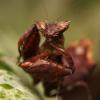I caught a queen very close to a forest and I'm 100% sure it's temnothorax, if anyone has tips on how to keep temnothorax, would be apreciated
- Formiculture.com
- Forums
- Gallery
- Members
- Member Map
- Chat

I caught a queen very close to a forest and I'm 100% sure it's temnothorax, if anyone has tips on how to keep temnothorax, would be apreciated
They're also highly polygynous if you find more queens.
"God made..... all the creatures that move along the ground according to their kinds (including ants). And God saw that it was good. Genesis 1:25 NIV version
Keeping:
Formica cf. pallidefulva, cf. incerta, cf. argentea
Formica cf. aserva, cf. subintegra
Myrmica sp.
Lasius neoniger, brevicornis
They're also highly polygynous if you find more queens.
Edited by CatsnAnts, July 29 2020 - 1:05 PM.
Polygynous species will kill queens if there are too many, but 1-5 is ideal for a small colony. Any more probably will be dismembered, as you mentioned..........That’s debatable. Most likely they will get along just fine, but they still have the tendency to kill of a queen here and there. Temnothorax ambiguus, for example, is known to be pleometric (although it’s probably because of limited resources, which isn’t a problem in captivity), one of my queens in my 8 queen colony has her antennae ripped of before being killed. My fifteen queen T. curvispinosus colony has now had three queens dismembered. If you start a colony, only introduce new queens for around three days after you put the original queens in the test tube, or else they will fight.They're also highly polygynous if you find more queens.
"God made..... all the creatures that move along the ground according to their kinds (including ants). And God saw that it was good. Genesis 1:25 NIV version
Keeping:
Formica cf. pallidefulva, cf. incerta, cf. argentea
Formica cf. aserva, cf. subintegra
Myrmica sp.
Lasius neoniger, brevicornis
They're also highly polygynous if you find more queens.
Not really... I believe they have the potential to be, but it seems like its usually more limited to pleometris. Like kael mentioned, pretty much all the wild temnothorax I've observed have been monogynous. Whether they were solitarily founded or secondarily monogynous is unknown to me.
I believe T. longispinosus exhibit pleometrosis, secondary monogyny, secondary polygyny and founding solitarily. That’s at least what I interpreted from its page on AntWiki.Not really... I believe they have the potential to be, but it seems like its usually more limited to pleometris. Like kael mentioned, pretty much all the wild temnothorax I've observed have been monogynous. Whether they were solitarily founded or secondarily monogynous is unknown to me.
They're also highly polygynous if you find more queens.
They're also highly polygynous if you find more queens.
That’s debatable. Most likely they will get along just fine, but they still have the tendency to kill of a queen here and there. Temnothorax ambiguus, for example, is known to be pleometric (although it’s probably because of limited resources, which isn’t a problem in captivity), one of my queens in my 8 queen colony has her antennae ripped of before being killed. My fifteen queen T. curvispinosus colony has now had three queens dismembered. If you start a colony, only introduce new queens for around three days after you put the original queens in the test tube, or else they will fight.
Thanks for the information ![]()
Thanks to everyone for this preciouse information ![]()
0 members, 0 guests, 0 anonymous users